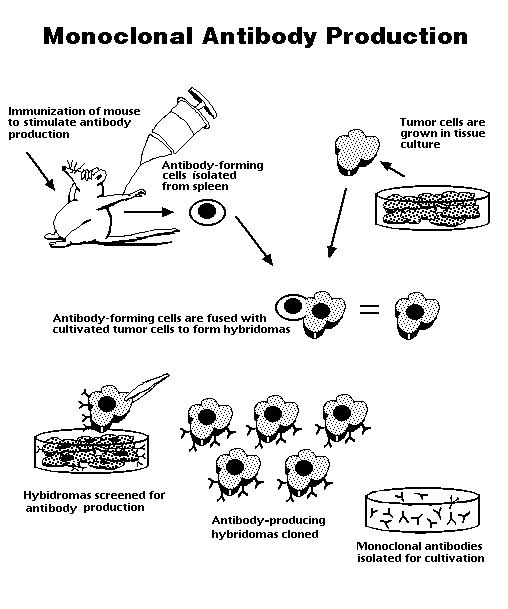Production and
Uses of Monoclonal Antibodies
The production of monoclonal antibodies is achieved
by the formation of hybridoma cells. As the
name suggests, hybridoma cells are formed from the hybridization, or fusion,
of two types of cells. The first component of a hybridoma cell is a myeloma
cell. Myeloma cells are cancerous plasma cells, which, like all
cancerous cells, are immortal. The second component of a hybridoma cell
is a spleen cell. Each spleen cell produces
a single specific antibody. Thus, when the myeloma cell and spleen cell
are fused, the resulting hybridoma is an immortal cell producing one specific,
or monoclonal, antibody.
Steps in producing monoclonal antibodies:
1) Inject a mouse with the antigen
against which you want monoclonal antibodies produced. This gets
the mouse's immune system to produce the antibody that will later be isolated.
2) Inject the mouse with the
antigen once more. This "boosting" ensures that the mouse
produces the right form of antibody needed in monoclonal antibodies, the
IgG form.
3) Isolate spleen cells (B lymphocytes).
The B lymphocytes will comprise the antibody-producing component of the
hybridoma cell.
4) Fuse isolated B cells with
myeloma cells. The myeloma cells are plasma cell (antibody-producing
cell) tumors. Myeloma cells, since they are cancerous, do not actually
secrete antibodies; however, they are immortal. Fusion of myeloma cells
with B cells creates immortal "hybridoma" cells that continually
produce one specific type of antibody.
5) Select for hybridoma cells
only by growing in HAT medium. Myeloma cells cannot live in the
presence of HAT, so unfused myeloma cells are quickly killed off. Furthermore,
while B cells can survive in the presence of HAT, their lifespan is limited,
so all unfused B cells will eventually die. In time, only hybridoma cells
survive. Each hybridoma produces one specific monoclonal antibody.
6) Use a probe against each
hybridoma to select hybridomas that secrete monoclonal antibodies of interest.
The probe should be the actual antigen that the antibody of interest recognizes;
one can detect antibody:probe interaction via a Western Blot.
The cartoon below is a depiction of the formation
of a hybridoma and the production of monoclonal antibodies:

Figure 1. This figure outlines the steps in creating
a hybridoma clone necessary for monoclonal antibody production.
Once monoclonal antibodies are isolated, there are
various uses. They are usually used as probes in various molecular biological
techniques such as Western Hybridizations or Chemiluminescence. Furthermore,
monoclonal antibodies are increasingly being used as therapeutic agents
in such diseases as cancer.
Finally, production of monoclonal antibodies can allow biologists to study
the structure of that particular antibody to determine critical reasons
why it recognizes specific epitopes.
References:
Janeway, C. and P. Travers. Immunobiology: the Immune System in Health
and Disease. Garland Publishing, 1997.
Anonymous. 1998, Jan. Monoclonal Antibody Production. <http://www.gene.com/ae/AB/GG/monoclonal.html>
Accessed 1998 Feb 18.
Back to Tom's Home Page
Send comments, questions, and suggestions to: tobeadle@davidson.edu

